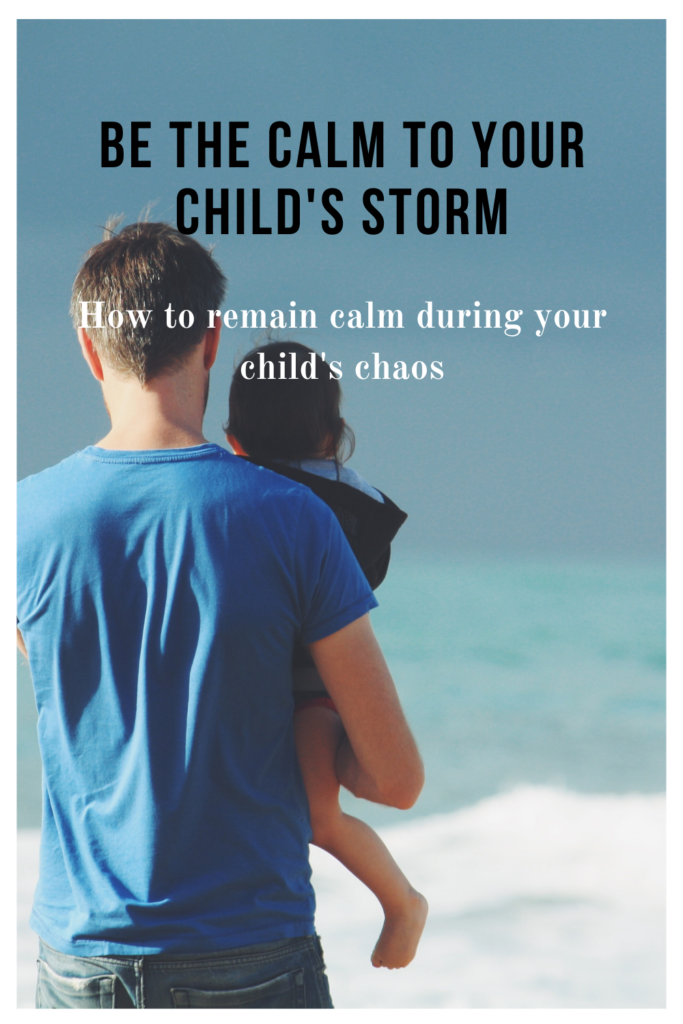If you’re a parent to a little one you have seen first hand how many storms your child gets into during the day. And by storms meaning things like temper tantrums, meltdowns, moments of frustration or power struggles. Kids can have a lot in one day!
What does your child’s mood do to you when they get into these storms? Hearing children’s thunder and clamor can send bolts of lightning of stress through parents too. Thunderstorms can be stressful and alarming, it’s natural for parents to respond to their kid’s storms with crashing thunder too.
Does this kind of reaction blow over the storm though? More than likely the answer is a resounding no. Instead it adds more fuel to the fire.
“When little people are overwhelmed by big emotions it’s our job to share our calm and not join their chaos.” –L.R. Knost
Today we’re going to unpack how you can be calm to your child’s storm. First, we’ll gain an understanding of why youngsters have the storms in the first place. When you understand where your child is coming from you will be able to help them through their blow-ups.
Then we’ll look at steps you can take to remain calm yourself as you work with your child to diffuse the situation.

Why Children Have Storms
What is the source of the thunderous cries or the raindrop tears? There is a good reason why your kiddo gets into these states. Let’s explore!
Storms Have Something To Say
Think back to when your kids were babies and couldn’t talk. They sure could fuss! It was their way of letting you know something was up. They were hungry, tired, cold or wet. Even though no words were exchanged you eventually figured out what your baby was trying to say.
Meltdowns are the same thing. When your child flops on the ground try to see this as a communication opportunity instead of fit of rage. Perhaps your kid has language skills, that doesn’t mean they are in a place to articulate themselves clearly.
Why?
When kids feel strong emotions in stressful moments their brains aren’t fully developed to rationalize the situation and release the appropriate response. Or the emotions get so overwhelming it can be hard to put those feelings into words. So you end up with a storm or a temper tantrum.
In these moments consider, “what is my child trying to tell me?” So what are they trying to say through their chaos?
Basic Needs Are Not Being Met
Do you get extra crabby when you’re tired or hungry? Kids get the same way. Adults usually know how to remedy the situation, grab a snack and you’re good to go.
Children don’t always have the skills or the ability to do that quite yet. So when your little one is short on sleep or it’s close to lunchtime you probably notice them getting fussy.
When your kids explode do a quick assessment to see if they are tired, hungry, or uncomfortable and give them what they need.
Unable To Clearly Express Self
Kids’ brains are power houses. It’s amazing to see how much language they pick up and skills they learn just through observation, growing and playing.
Still kids’ brains are not fully developed. It can be a challenge to clearly express their thoughts or get ideas out. They have the thoughts in their mind, but it gets lost in translation when trying to talk. For this reason many tantrums occur.
Kids get misunderstood and it’s frustrating. Kids get frustrated at themselves because they can’t figure out how to say it. Youngsters know what they want but can’t get it out because they don’t know how to say it.
If you have sneaking suspicion that this is the cause of your child’s storm tuning into your child’s cues and giving them the words greatly helps. Help them along by saying, “I wonder if you’re wanting….”
A Sign Of Being Unregulated
When children are unregulated a myriad of emotions come out. There are different types of regulation too.
With emotional regulation, people know how to manage their emotions and express them appropriately. When littles are emotionally unregulated they don’t know how to deal with things like anger or sadness. So they resort to shutting down or melting down.
With self-regulation people know how to physically keep their bodies feeling good or comfortable. Kids’ bodies may get off kilter which can cause agitation. If kids have self-regulation they know to get moving if they’ve been sitting for too long. If they’re feeling revved up they know how to calm their bodies down. Not all kids, especially toddlers, have this awareness and so out come the difficult behaviors.
When you see signs of distress this could be the cause. In that case, get your kids to move about or do things to help slow down depending on the situation. Jump, crash into pillows, squeeze a ball, blow bubbles. These are all great activities to help with regulation.
Feeling Out Of Control
Kids find security with predictability and boundaries. When routines or things get switched up children can feel untethered. This may cause kids to act out more.
Littles also like to be in control of things in their world too. They like to have things go their way or believe things work a certain way. There might be times when that gets interrupted, they don’t like it and then get in power struggles with mom or dad. You might see it when you tell your kiddo it’s time to go and they are not done playing. Or when your child wants to go outside with no coat and it’s 10 degrees outside.
To help address this issue give kids choices or let them be in control of things within a limitation. Like, set the expectation that they need to be done but can choose to play for either 1 or 2 minutes more.
There are many other reasons why kids have temper tantrums so this list isn’t exhaustive. However hopefully this gives you some insight into your child and why they have their storms. Hopefully with deeper understanding comes compassion, which is helpful in remaining calm ourselves.
Now let’s move into being calm to our kid’s chaos. No matter the reason behind their meltdowns we can work with them to help through these trying times and give them valuable social-emotional skills along the way.

How To Be The Calm In The Storm
You hear screaming and crying from another room. You go to your child and see your them crumpled up on the floor. You ask what’s going on. Your child looks up at you and starts yelling words that you don’t exactly understand. You ask more questions which brings on more yelling. Offer to help and more yelling.
Now your head is swirling. “How can I help? I don’t know what to do. This is too loud. They can’t talk to me this way. Why won’t they just tell me what happened? Why do they reject my help? I have work to do I don’t have time to deal with this. I’m not getting through to them.” You feel yourself start to boil over and you hear yourself raise your voice. You might be feeling things like anger, frustration or impatience.
This happens a lot for many parents (though probably doesn’t get talked about much) so you’re not alone.
Witnessing our kid’s angst is unpleasant and stresses us out! Like our littles when things don’t go right we get caught up in a storm. Unlike our kids though we have the ability to remain calm in sticky situations and can teach our kids the same skills so that one day they can have less storms. Here’s how you can try being their calm.
Remain Calm
This may seem like an obvious instruction. You might be thinking, “I know to remain calm but how do you actually do that?”
Focus on self-calming strategies for yourself. For a moment tune your child out and slowly count to 10 to gather your thoughts. Close your eyes and take a few deep breaths. If you need to step away for a minute. Tell your child you need a moment will be right back.
When you feel like your heart isn’t racing and you cleared your mind, remind yourself not to add to the chaos. Remind yourself that your child needs your help. Remind yourself that you will be able to get back to doing what you were doing before the storm hit.
Then get back in there to handle the situation with your child. You got this!
Keep A Neutral Stance
Did you know lightning rods protect buildings from direct lightning strikes by neutralizing the charges? Doing so does things like reduce the chances of fire or other damage.
Be like the lightning rod and remain neutral to tamper their fire. What does that look like?
As you approach your child in their storm keep your voice neutral. Refrain from showing emotion in your voice, like don’t sound angry or happy. Be cool and collected.
Remain neutral in the words you say by refraining from expressing opinions. Acknowledge how your child feels. Let them know you see or hear what they are going through.
Instead of saying “I think you need to do this…” or “That’s not the right way to behave…” These types of statements are invalidating. Now more than ever your child just needs to be understood and heard. They need security from you.
Say things like, “I see this makes you upset…” or “I understand this is tough…” These types of statements are validating. It tells your child that they are not alone in this and they can turn to you for help. You may find that when they feel understood their storm starts to simmer and you can work through the situation sooner.
Keep your words to a minimum. Too much verbal input can be overwhelming to a stressed-out youngster.
Lower your expectations of their logic. You probably can recall things your child has said during a tantrum that sound obscure. High emotions increase their impulsiveness to say irrational things. Now is not the time to reason with your kiddo, you can do that after they are in a better state of mind.
Ride Out The Storm Together
As you remain calm and take a neutral stance join your child at their level to ride out the storm. If your little one needs a hug simply sit and snuggle together. If they want to sit on the ground, sit beside them. If they just want to talk, listen.
Like a sail flapping in the wind on the stormy seas, it takes effort to pull the lines and trim the sail. Eventually you regain control of your ship and can get back on course. That is what you’ll see when you ride out the storm together.
Process The Storm Together
When things calm down now is the time when you and your child can work together to resolve the issue that started it all.
See if you can make sense of the cause for the tantrum. Perhaps one of the reasons mentioned above was the culprit. If so try one of the techniques already discussed.
Describe the situation to help your child connect the dots between the trigger, their reaction and emotions.
Review the situation and brainstorm ideas to try for next time.
Offer suggestions for your child to ask for help, express their emotions, or problem solve.
Talk to your child about what is okay to do and not okay.
Hopefully, this guidance equips you to remain calm to your child’s storm. It is a process to learn so give it time and give yourself grace if you don’t follow it every time. When you step out with the intention to be calm for yourself and your child you’ll be able to diffuse the situation and learn things from it too.